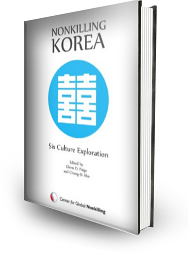Can Korea Defy Its Deadly Past?
(Review of Nonkilling Korea: Six Culture Exploration by Taehwan Kimfrom, Global Asia, Vol. 7, No. 1, Spring, 2012). “Nonkilling” is not so widely used a term as “nonviolence” in the social sciences, and, in particular, political science. In choosing their title, the editors of this book intend to describe “a Korea in which no Koreans kill other Koreans, no foreigners kill Koreans, and no Koreans are sent abroad to kill foreigners.” More broadly, this book attempts to explore “nonkilling” as the “absence of weapons specifically designed to kill and absence of ideological justifications for killing.”
This book thus aspires to be global and universal in its ideals, but local and idiosyncratic in its analytical focus. It explores six cultures — those of North and South Korea, the United States, Japan, China and Russia. The Korean Peninsula is the focal point of the volume, because of the lethal structure of killing that culminated in the Korean War, in which the killing cultures of these six countries converged. By discovering, developing and eventually combining the “nonkilling” assets and capabilities inherent in these six cultures, the contributing authors argue that a “nonkilling” world can be realized.
This book is admittedly a preliminary work that invites further exploration by readers, experts and non-experts alike. Its comparative analysis of killing and nonkilling cultures is limited, as the book simply juxtaposes these six cultures without interrelating them to each other.
About the book
The Center for Global Nonkilling released Nonkilling Korea: Six Culture Exploration in January 2012, which includes a selection of eight chapters from the “Nonkilling Korea: Six Culture Exploratory Seminar” convened by the Asia Center/Seoul National University and the Center for Global Nonkilling in Seoul during August 18-19, 2010. The book has been simultaneously published in two separate editions by CGNK and the Seoul National University Press. The CGNK edition can be ordered online here. The SNU Press edition can also be ordered through their website.
In contrast to academic and policy studies that concentrate on political-military-economic aspects of Korea since Division and the Korean War, authors in this book seek to discover nonkilling cultural features in South and North Korea, America, China, Japan, and Russia that can contribute to realization of a unified Nonkilling Korea – A Korea in which no Koreans kill other Koreans, no foreigners kill Koreans, and no Koreans are sent abroad to kill. Discoveries reported here provide confidence that nonkilling cultural values and capabilities can be found in all six societies that can benefit each and all in progress toward the measurable goal of a killing-free Korea and world. Readers are invited to join in further explorations.
The book is edited by Glenn D. Paige and Chung-Si Ahn, and includes a Foreword by former ROK ambassador to the United States Professor Sung Chul Yang. Contents include: “Introduction” by Glenn D. Paige; “Spiritual and Practical Assets of Korean Nonviolence” by Jang-seok Kang; “Nonkilling in North Korean Culture” by Glenn D. Paige; “From Nonkilling to Beloved Community” by Michael N. Nagler and Stephanie N. Van Hook; “Possibilities of a Peaceful Nonkilling China” by Dahua Tang; “Nonkilling in Japanese Culture” by Mitsuo Okamoto and Tamayo Okamoto; “Evolution of the Idea of Nonkilling in Russian Culture” by Tatiana Yakushkina; “Nonkilling in Russian Culture” by William V. Smirnov and “Conclusion” by the editors.




